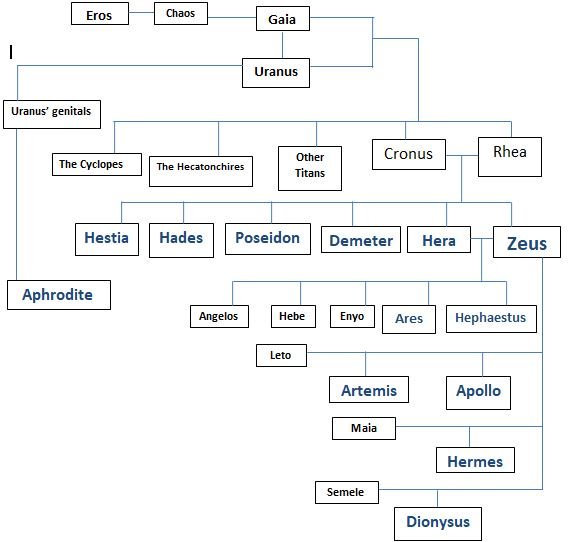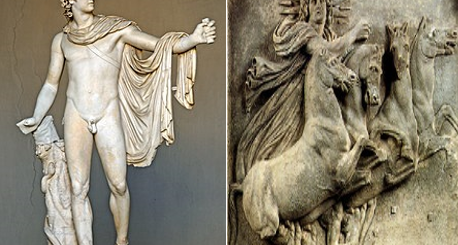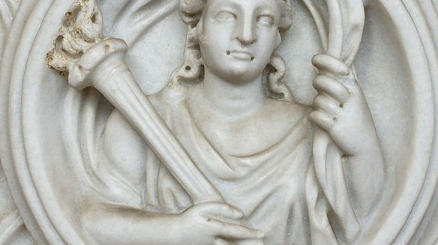Gaia: Greek Goddess of the Earth

Gaia presenting the baby Erichthonius to the goddess Athena | Erichthonius would go on to become the king of Athens. And who better to raise him than the patroness of Athens, Athena |Image: an Attic red-figure stamnos, 470–460 BC
Recognized as one of the main primordial gods in ancient Greece, Gaia was venerated as the goddess of the Earth or land. According to the myth, she is both the mother and husband of the sky god, Uranus. The Greeks worshiped her as the mother of all life forms, making her a very important deity in the Greek pantheon.
What is Gaia’s origin story? And what role did she play in ancient Greece?
World History Edu presents crucial myth surrounding Gaia’s meaning, worship and powers.
Gaia – Mother Goddess in ancient Greek religion
Goddess of: Earth, land
Parents: None, or in some cases Chaos
Siblings: Chaos, Eros, Thalassa, Erebus, Tartarus, Nyx
Husband: Uranus, Tartarus, Aether
Children: the Titans, Pontus, the Cyclopes, Nereus, Typhon, Hecatonchires
Association: Demeter, Rhea
Symbol: plants, trees, herbs, fruits, soil
Epithets: Embodiment of the Earth; the Great Nurturer; Mother of the Titans
Worship place: Sparta, Athens
Roman equivalent: the goddess Terra
Egyptian equivalent: the god Geb
Gaia Goddess Origin Story
According to the ancient Greek poet Hesiod, Gaia emerged from the vast void (Chaos) that existed before the birth of the universe. Following the emergence of Gaia, the likes of Tartarus (the deep abyss) and Eros (deity of love) came.
However, Gaius Julius Hyginus, a Latin author, states that Gaia (Earth), Sea and Heaven are rather the children of Aether (the air) and Hemera (Day).
Who are the children of Gaia?
It is also believed that Gaia brought into existence deities such as Uranus (sky), Pontus (sea), and Ourea (Mountains). She gave birth to Uranus (a sky god) in order to serve as cover over her.
In some accounts by Hesiod, it is stated that Gaia gave birth to her children all by herself, without any father.
The goddess also laid with Uranus and gave birth to numerous deities, including Titans such as Oceanus, Phoebe, Mnemosyne, Tethys, Crius, Hyperion, Iapetus, Rhea, Theia, Themis, and Cronus.
The Greeks believed that Gaia had the following offspring with Uranus:
- the first Cyclopes (one-eyed giants) – Arges (Bright), Steropes (Lightning), Brontes (Thunder)
- the Titans – Cronus, Rhea, Oceanus, Tethys, Iapetus, Themis, Phoebe, Hyperion, Coeus, Crius, Mnemosyn and Theia.
- the Hecatonchires (giants with fifty heads and hundred arms)– Cottus, Gyges, Briareos
Gaia also lay with her son Pontus and gave birth to Nereus, Ceto, Eurybia, Thaumas, and Phorcys.
From the union between Gaia and Tartarus, came forth Typhon – the youngest of her sons. Typhon portrayed as a fire-breathing monster with hundred dragons’ heads. He is an important character in Greek mythology, as he features prominently in the period that saw the Olympians take the reins of power from the old gods (i.e. the Titans).
Family tree

Gaia goddess – Family tree
The overthrow of Uranus
Shortly after the birth of the Cyclopes and the Hecatonchires, Uranus is believed to have hidden those children in a place where Gaia could not see them. According to Hesiod, this act of Uranus caused immense pain to the Mother Goddess.
Worried about Uranus’ lustful and unbecoming attitude, Gaia fashioned out a grey flint sickle – an adamantine. She then handed the sickle to one of her grandsons, Cronus, the Greek god of the harvest.
Just as Uranus was about to lie with Gaia, Cronus took out the sickle and cut the genitals of his father . Gaia then used the spilled blood of Uranus to create Erinyes, the Giants, and the Meliae (tree nymphs).
And from Uranus’ testicles, the Greek goddess of love, beauty and lust Aphrodite emerged.
With Uranus overthrown, Cronus became the ruler of the universe. However, his reign on the throne would not last that long as his own children later overthrew him.
How Gaia helped Rhea save the life of Zeus
Similar to his father Uranus, Cronus ended up growing very paranoid of his children. Cronus had learnt from his parents – Gaia and Uranus – that one of his children will usurp him. Determined to avoid such a miserable fate, Cronus swallowed the children he had with sister and wife the Titaness Rhea.
After the birth of her last child Zeus, Rhea sought the help of her mother Gaia who advised Rhea to wrap up a stone like a baby and present it to Cronus. Tricked into thinking that the stone was the baby Zeus, Cronus quickly swallowed it. By so doing, the life of Zeus was sparred.
Rhea placed the baby Zeus in the care of Gaia, who would raise Zeus and teach him a great deal of things.
Gaia and Zeus
Greek goddess Gaia also prepared Zeus in the art of combat and other magical things. She did this so that Zeus could defeat Cronus and bring an end to the tyrannical reign of Titans.
Zeus grew up to be a strong and powerful god, and thereafter he proceeded to free his siblings – Hades, Demeter, Hera, Poseidon and Hestia – from the belly of Cronus. Zeus and his siblings (the Olympians) defeated Cronus and the Titans during the Titanomachy.
However, Gaea soon got enraged when Zeus started banishing her children – the Titans – to Tarturus, the deepest depths and darkest part of the Greek Underworld. From then onward, Gaia came to oppose Zeus.
It’s said that Gaia brought forth the hideous monster Typhon to challenge Zeus. However, that plan failed as Zeus pelted Typhon with his powerful thunderbolt. With Typhon defeated, Gaia went on to prophesize that Zeus would be usurped by one of his children.
Afraid of the prophecy, Zeus, just like his father before him, swallowed his son Metis, who got lodged in the forehead of Zeus; and shortly after, the goddess Athena popped out from Zeus’ forehead as all full-grown and wearing battle gear.

In the Greek pantheon, Gaia (Earth) is famous for being the grandmother of the Greek Olympian gods and goddesses | Names in blue are the Olympians (Note: In some cases Hestia, the goddess of the hearth, and Hephaestus, the god of forges and fire, are excluded from the list of Olympian gods and goddesses)
Meaning, Symbols and Epithet
Although the origin of the word “gaia” is not clear, it’s commonly accepted that the word means “Earth” or “land”.
In terms of the epithets her worshipers used to describe her, she was sometimes called “Anesidora” – the “giver of gifts”. This epithet of Gaia perfectly summarizes her motherly nature as someone who always gives.
Other epithets of Gaia include, Calligeneia, Pandoros, and Eurusternos.
Why were earth and water considered symbols of submission in the ancient world?
Worship
Gaia’s worship places were often times associated with Demeter, the Greek goddess of the harvest and agriculture. It was also not uncommon for black animals to be sacrificed to both of those goddesses. Being the goddess of the earth, it makes quite a lot of sense for her to be associated with a deity who is in charge agriculture and harvest.
The ancient Greeks also worshipped Gaia for her prophetic abilities. Bear in mind, it was Gaia who prophesized the downfall of Cronus at the hands of one of his children. Therefore, it is not surprising that some Greeks worshiped her as the force behind the Oracle at Delphi. She is believed to have granted her prophetic powers to the likes of Apollo and in some cases Poseidon.
It very much possible Apollo inherited his prophetic powers after killing Python – one of Gaia’s children.
Common places of worship included the temple of Ge Eurusternos near Aegea. A number of Gaia temples also existed in Sparta and Athens.
There were also statues, altars and shrines in temples of other Greek gods devoted to her worship. For example, the Temple of Demeter typically had Gaia statues.
Depiction
The Greeks generally depicted Gaia with the features that highlighted her motherly role. For example, many paintings on vases show her holding a baby or handing a baby over to someone, as she emerges from the earth.
Often times, she is shown wearing green clothes – a symbolism of her fertility and the greenery on Earth.
The importance of Gaia in ancient Greece
In the time before time, Gaia burst out of the cosmic void and went on to give birth to the Greek deities. She is the primeval one who gave form to the landscape of the universe, which includes celestial bodies, animals, plants and man. In this role, she can be described as the one who oversees all life on earth.
Gaia’s importance lies in the belief that the Greeks considered her to be the deity who nourished every living thing on earth.
As a primordial mother goddess, it was believed that she provided affection and comfort to all her creations. It is for this reason she was in some way seen as “the Great Nurturer”. Upon death, ancient Greeks believed that her creations returned to her, the Earth goddess.
Major Gaia Facts
- According to one Greek creation myth, Gaia and her siblings – Chaos and Eros (love) – existed at the beginning of time. It was believed that the trio emerged from the Cosmic Egg (or the Void).
- Gaia was a deity known for fighting against cruel gods. It is interesting to note that she always lent a helping hand to deities that were willing to overthrow ruthless gods. Take the examples of Cronus and Zeus, who were both the youngest sons of their fathers; Cronus – Uranus’ youngest son – overthrew his father. Zeus’ – youngest son of his parents – overthrew his father, Cronus.
- In one version of the myth, Hephaestus, the Greek god of fire and forges, tried to rape Athena. Hephaestus failed; however, a drop of his seamen fell on Athena’s thigh. Athena wiped off the fluid with a wool and then cast it upon the earth. In the end the remnants of the seamen fertilized Gaia, producing the famed Greek hero Erichthonius, who would go on to rule Athens.
- The ancient Greeks believed that Gaia was deity who made Aristaeus immortal.
- Because Zeus hid Elara deep in the earth, Tityos – the son he bore with Elara – has sometimes been considered as the son of Gaia.
- In some cases, her Roman name was said to be Anesidora, meaning “she who sends gifts”. This name was also used to describe several goddesses and mythological figures, including Demeter, the goddess of the grains and harvest, and Pandora, the first woman on earth created by the Greek god Hephaestus.
FACT CHECK: At World History Edu, we strive for utmost accuracy and objectivity. But if you come across something that doesn’t look right, don’t hesitate to leave a comment below.



























